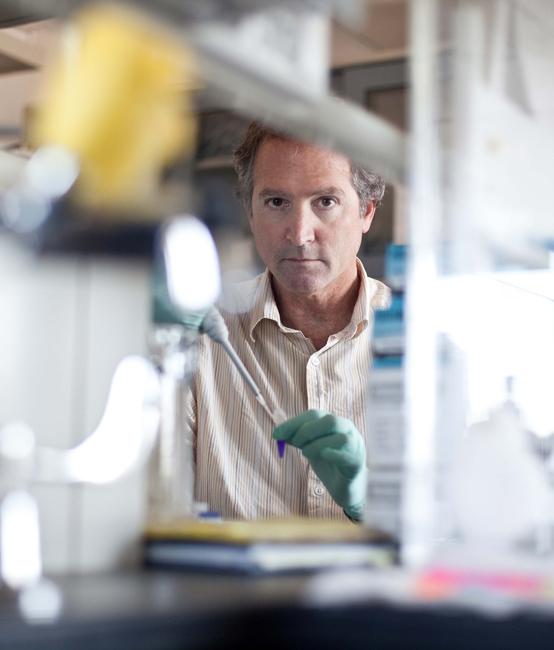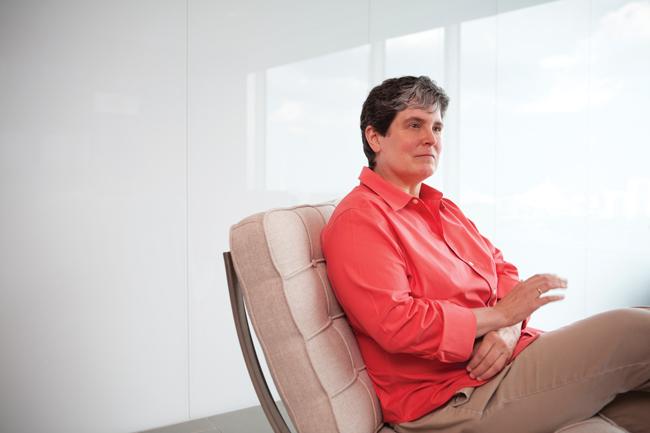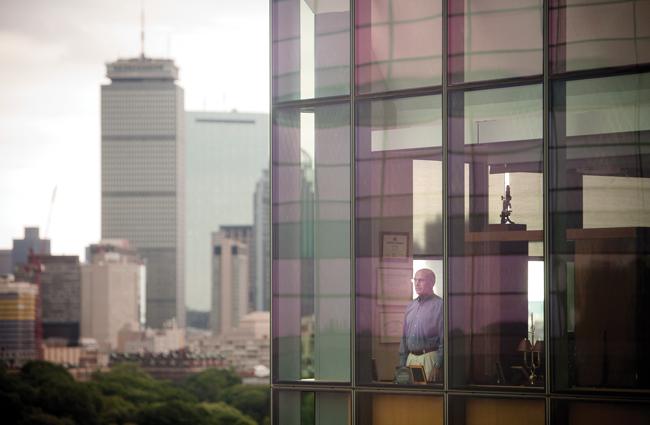Cottage Industry
Humans and the life forms they host are in it together
- Feature

You are a walking ecosystem. And you are not alone. Ever.
Microbial life teems on, and in, your body. If you’re healthy, these life forms live in harmony with you in a stable and balanced system, where host and guest alike contribute to the rhythm and hum of a cooperative community.
Humans and microbes have coevolved to a point of mutual benefit—we need each other. The number of microbial cells in our bodies outstrips the number of human cells by about ten to one. And while the human genome contains approximately 30,000 genes, the microbial genome, the microbiome, is made up of more than four million genes. We are more “them” than “us.”
There’s a growing interest in studying the ecosystem that is the human microbiome, and it’s more than a research trend. It may herald a shift in how we think about human health and medicine and our place in the natural world.
Compartment Living
The human microbiome comprises organisms and their genomes—bacteria, viruses, fungi, and other single-celled eukaryotes—that occupy several body habitats: the gut, mouth, nasal passages, vagina, and skin. Each of these habitats features organisms, collectively the microbiota, that have adapted to, and even shaped, their particular niche. Not only is the mix of microbes living in the gut different from that on the skin, but there are microhabitats within habitats. The microbiota just inside your nostril, for example, differ from those living deeper in the passageway inside the sinus cavity. And that’s not all. The continual interplay between a person’s genetic makeup and the surrounding environment also influences how a microbiome is populated.
A healthy microbiome is highly diverse, stable, and resilient: diverse, in order to avoid species domination and to provide a wide set of functions; stable, in order to keep body functions running smoothly; and resilient, in order to recover from the inevitable assaults. Disturb it and it will likely recover, but it will never be the same.

The microbes that live with us are active community members. And as you might find in any community, some members contribute to the greater good, some remain neutral, and some may become harmful given certain conditions. Among other functions, microbes help digest and extract nutrients from food, regulate metabolic processes, guide immune system responses, and protect against invasions by pathogens. In a healthy person, the beneficial bacteria help create a stable environment that promotes and protects the health of the human host.
In fact, these microbes adapt to, and perhaps even determine, the biological properties of the human host. David Relman ’81, the Thomas M. and Joan C. Merigan Professor in the Departments of Medicine and of Microbiology and Immunology at Stanford University and chief of infectious diseases at the VA Palo Alto Health Care System in California, describes the microbiome as a “complex set of communities of microorganisms that have chosen the human body as their home and that operate as a unit, as most communities do. By doing so, they are furthering their own beneficial purposes, both for themselves and for their host.”
Home Grown
The microbial species that call us “home” operate in a symbiotic relationship with their hosts in an ancient contract revised over eons of coevolution. In this mutually beneficial system, humans provide food and shelter while the microbes provide protection from harmful invaders and help with essential body functions.

Infants are born with almost no microbiota: They acquire some during birth, although the mix and type of microbes differ depending on method of delivery. Babies born vaginally acquire microbiota from their mothers during the trip through the birth canal, whereas babies born by cesarean delivery receive their introductory dose of microbiota from contact with their mother’s skin. This first exposure is the initial step in developing an immune system and helps determine the composition of an infant’s microbial community. These early differences diminish in importance as other influences, such as diet, health, and geographic location, begin to hold sway and shape a child’s microbiome.
A microbiome can also assemble, or reassemble, after a disturbance, such as treatment involving an extended or repeated courses of antibiotics. Such therapy may well eradicate a targeted pathogen but, as collateral damage, also knocks out some of the beneficial or benign microbiota. If the community is resilient, the microbiome may return to its pre-disturbance state, but this recovery takes time and is far from guaranteed.
And, under the right conditions, an invasive pathogen can take advantage of a vulnerable community to gain a foothold in, or attempt to colonize, the host. Part of the microbiome’s responsibility is to help defend its host from pathogens by making surface environments inhospitable to invading species, a process referred to as “colonization resistance.”
“The particular difficulty for organisms that don’t normally live with us, ones that are actually pathogens from the outside world,” says Katherine Lemon ’01, an HMS assistant professor of pediatrics at Boston Children’s Hospital and the Forsyth Institute, “is that they not only have to deal with our defenses, like our immune system, they also have to come into an established microbial community.”
While the immune system can generally withstand such assaults, if the pathogen is especially aggressive or plentiful, the invasion may succeed and alter the mix of microbiota.
“Understanding the means of microbiome assembly,” says Relman, “is key to managing pathogen invasions and to thinking of human health as a collective property of the human body and its associated microbiome.”
Balancing Act
The immune response presents a formidable defense, and if the response subsides after a threat has passed, all is well. Sometimes, however, the response continues without reason, a characteristic of autoimmune disorders such as Crohn’s disease, ulcerative colitis, multiple sclerosis, psoriasis, type 1 diabetes, and asthma.

In the United States and other developed countries, the incidence of autoimmune diseases has been on the rise over the past 30 to 40 years, a situation some experts attribute to changes in the microbial balance in humans. A number of factors, such as overuse of antibiotics and of hormones, both in the animals we eat and in therapeutics, have, according to Dennis Kasper, William Ellery Channing Professor of Medicine and an HMS professor of microbiology and immunobiology, “affected the microbiome and caused a shift so that now we don’t have the organisms that were properly balancing our immune system and preventing us from getting some of these diseases.”
Ebbs and flows in the balance of an individual’s microbiota may help explain the cyclic nature of some autoimmune diseases in humans. But it’s not just that gut bacteria become imbalanced. “You also have to have a genetic susceptibility,” says Kasper. “The fact that the bacteria become imbalanced, and you’re genetically susceptible, can partly explain why conditions like multiple sclerosis occur in individuals and why the diseases are relapsing and remitting in nature.”
People living in developed countries may be becoming less dependent on coevolved gut microbiota. Some researchers, including Kasper, think that the increase in autoimmune disorders, sometimes called microbiome-based disorders, could be a consequence of the greater vulnerability of the host–microbiota relationship partly caused by trends such as eating highly processed foods and living in overly hygienic environments.
Seed Catalog
Ecological models have long used the metaphor of a symbiotic, mutually beneficial, and dynamic community to frame discussions of the degree of ecosystem health. The idea of the human body as an ecosystem is gaining traction in microbiome research, with human health being viewed as a “service” delivered in part by resident microbiota.
“All you have to do,” says Relman, one of the principal proponents of this concept, “is borrow the language of ecologists and read their literature, and suddenly you’re looking at the world in a very different way. And the implication of that new perspective for medicine is that we are going to have to develop a whole different set of tools dedicated to restoring and maintaining the beneficial properties of the microbiota.”
Some of these future tools may include using environmental perturbation as a therapy. You could, says Lemon, “introduce an organism and use it to create a colonization blockade, where you have a harmless organism occupy the same niche as a harmful one, for instance, Staphylococcus aureus. And allow the harmless one to take hold.” This replanting and reseeding approach is microbiota management—stewardship to promote human health.
Fecal transplantation, another example of replanting and reseeding, is being used in humans now, although only in people who are sickened by recurrent Clostridium difficile infections. Although it has enjoyed some success, Kasper says that “the problem with probiotics or fecal transplants is that the introduced organisms will potentially still be there after the disease has ended. And we don’t know what their long-term effects are.”
Microbiome research is in a honeymoon period, when the excitement of discovery peaks. There is a luster to the symbiosis between humans and our resident microbiota that many hope will be burnished rather than tarnished as researchers gain a better understanding of how human health is affected by our own actions and those of our nearest neighbors.
Susan Karcz is assistant editor of Harvard Medicine magazine.